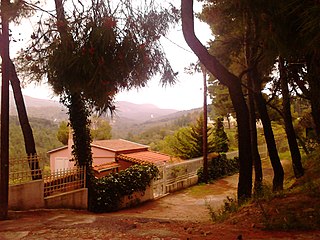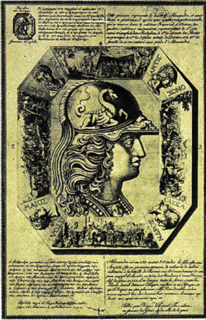Related Research Articles
The original Nicene Creed was first adopted at the First Council of Nicaea in 325. In 381, it was amended at the First Council of Constantinople. The amended form is also referred to as the Nicene Creed, or the Niceno-Constantinopolitan Creed for disambiguation.

The League of Corinth, also referred to as the Hellenic League, was a confederation of Greek states created by Philip II in 338–337 BC. The League was created in order to unify Greek military forces under Macedonian leadership (hegemony) in their combined conquest of the Persian Achaemenid Empire.

Arius was a Cyrenaic presbyter, ascetic, and priest best known for the doctrine of Arianism. His teachings about the nature of the Godhead in Christianity, which emphasized God the Father's uniqueness and Christ's subordination under the Father, and his opposition to what would become the dominant Christology, Homoousian Christology, made him a primary topic of the First Council of Nicaea convened by Emperor Constantine the Great in 325.

The Codex Bezae Cantabrigiensis, designated by siglum Dea or 05, δ 5, is a codex of the New Testament dating from the 5th century written in an uncial hand on vellum. It contains, in both Greek and Latin, most of the four Gospels and Acts, with a small fragment of 3 John.

Acharnae or Acharnai was a deme of ancient Athens. It was part of the phyle Oineis.
In 4th-century Christianity, the Anomoeans, and known also as Heterousians, Aetians, or Eunomians, were a sect that upheld an extreme form of Arianism, that Jesus Christ was not of the same nature (consubstantial) as God the Father nor was of like nature (homoiousian), as maintained by the semi-Arians.
The Council of Ariminum, also known after the city's modern name as the Council of Rimini, was an early Christian church synod.
The Council of Seleucia was an early Christian church synod at Seleucia Isauria.
The Arian controversy was a series of Christian disputes about the nature of Christ that began with a dispute between Arius and Athanasius of Alexandria, two Christian theologians from Alexandria, Egypt. The most important of these controversies concerned the relationship between the substance of God the Father and the substance of His Son.
Chrysanthos of Madytos was a Greek poet, chanter, Archimandrite, and Archbishop, born in Madytos. In preparation of the first printed books of Orthodox chant, he was responsible for a reform of the Byzantine notation within the New Music School of the Patriarchate, along with Gregorios the Protopsaltes and Chourmouzios the Archivist who transcribed the traditional repertory into the Chrysanthine notation.
Papyrus 19, signed by 19, is an early copy of the New Testament in Greek. The manuscript paleographically has been assigned to the 4th or 5th century.

Papyrus 100, designated by siglum 100, is an early copy of the New Testament in Greek. It is a papyrus manuscript of the Epistle of James. The surviving texts of James are verses 3:13-4:4; 4:9-5:1, they are in a fragmentary condition. The manuscript has been assigned paleographically to the late 3rd century, or early 4th century.
The Epistula ad Carpianum or Letter of Eusebius is the title traditionally given to a letter from Eusebius of Caesarea to a Christian named Carpianus. In this letter, Eusebius explains his ingenious system of gospel harmony, the Eusebian Canons (tables) that divide the four canonical gospels, and describes their purpose, ten in number.
Panayotis Koupitoris was a writer from the island of Hydra.
Codex Sinaiticus and Codex Vaticanus, two of the great uncial codices, representatives of the Alexandrian text-type, are considered excellent manuscript witnesses of the text of the New Testament. Most critical editions of the Greek New Testament give precedence to these two chief uncial manuscripts, and the majority of translations are based on their text. Nevertheless, there are many differences between these two manuscripts. According to Dean Burgon: "It is in fact easier to find two consecutive verses in which these two MSS differ the one from the other, than two consecutive verses in which they entirely agree."

The Pamphlet of Rigas Feraios is a large chalcography printed in Vienna in 1797 by Rigas Feraios. It depicts a portrait of Alexander the Great framed by war scenes and portraits of his generals. The etching was incised by François Müller, who cooperated with Rigas for his cartographic work which he published the same year: Rigas' Map of Greece (1797), the New Map of Wallachia (1797) and the General Map of Moldavia (1797). It was released in 1200 copies from the printing press of Nitsch. One of the two copies that have been discovered in Greece is displayed in the National Historical Museum of Greece.

The General Map of Moldavia is one of the two maps of the Danubian Principalities which was printed by Rigas Feraios in 1797, the other being the New Map of Wallachia. He printed it in Jacob Nits’ printing press and the engraving was made by Franz Müller. The map is of 82 x 63 cm. in black and white and it is printed on paper from Holland. Its full title is "GENERAL MAP / OF / MOLDAVIA,/ AND PART OF ITS NEIGHBOR PROVINCES/. Published by Rigas Velestinlis from Thessaly for the sake of Greeks and philhellenes, 1797. Engraved by Francois Müller in Vienna".
Theodosius II, lay surname Christianopoulos (Χριστιανόπουλος) served as the Ecumenical Patriarch of Constantinople between 1769 and 1773.
Heortasius was a 4th-century bishop of Sardis and attendee at the Councils of Seleucia and Constantinople. He was a proto-Catholic who was sent into exile by the Semi-Arian faction following their victory at the afore-mentioned Councils.

The Iron Age Greek migrations were effected by a population of émigrés from amidst the displacements and reconstruction that occurred in Greece proper from the middle of the 11th century to the end of the 9th century BCE. The movements resulted in the settlement of the Aegean islands, Cyprus, Crete and the western coast of Asia Minor and the founding of new cities, which afterwards became centers of the Greek civilization. The migrations by various tribal groups were effected in consecutive waves known as the Aeolic, Ionian, Doric and Achaean (Arcadian) migrations. The movements differed from the Greek colonisation of the Archaic period in that they were more ad hoc affairs, rather than being the result of a planned process of colonisation on the part of the mother city. They are also less well-documented historically and in folk histories are often said to have been led by a mythologized or semi-legendary leader, such as Hercules or Orestes.
References
- ↑ Socrates Scholasticus, Church History, book 2, chapter 41.
- ↑ Philostorgius, in Photius, Epitome of the Ecclesiastical History of Philostorgius, book 4, chapter 12 and book 5, chapter 1.
- ↑ Socrates Scholasticus, Church History, book 2, chapter 41.
- ↑ Philostorgius, in Photius, Epitome of the Ecclesiastical History of Philostorgius, book 4, chapter 12 and book 5, chapter 1.
- ↑ Socrates Scholasticus, Church History, book 2, chapter 41.
- ↑ Philostorgius, in Photius, Epitome of the Ecclesiastical History of Philostorgius, book 4, chapter 12 and book 5, chapter 1.
- ↑ Socrates Scholasticus, Church History, book 2, chapter 41.
- ↑ Socrates Scholasticus, Church History, book 2, chapter 41.
- ↑ Philostorgius, in Photius, Epitome of the Ecclesiastical History of Philostorgius, book 5, chapter 1.
- ↑ Zenos' translated edition of Socrates Scholasticus, Church History, book 2, chapter 41.
- ↑ ΣΩΚΡΑΤΟΥΣ ΣΧΟΛΑΣΤΙΚΟΥ ΕΚΚΛΗΣΙΑΣΤΙΚΗ ΙΣΤΟΡΙΑ
- ↑ Louis Ellies Du Pin, William Wotton, A New History of Ecclesiastical Writers:: Containing an Account of the Authors of the Several Books of the Old and New Testament; of the Lives and Writings of the Primitive Fathers; an Abridgment and Catalogue of Their Works; Their Various Editions, and Censures Determining the Genuine and Spurious. Together with a Judgment Upon Their Style and Doctrine. Also, a Compendious History of the Councils; with Chronological Tables of the Whole, Volumes 1-2 (Abel Swalle and Tim. Childe, 1693) p265.
- ↑ Formulary of the Council of Ariminum Approved by the Acacians. List of the Deposed Chief-Priests, and the Causes of their Condemnation.
- ↑ Formulary of the Council of Ariminum Approved by the Acacians. List of the Deposed Chief-Priests, and the Causes of their Condemnation.
- ↑ Charles Joseph Hefele, A History of the Councils of the Church: from the Original Documents, to the close of the Second Council of Nicaea A.D. 787 (Wipf and Stock Publishers, 1 Feb. 2007) p273.